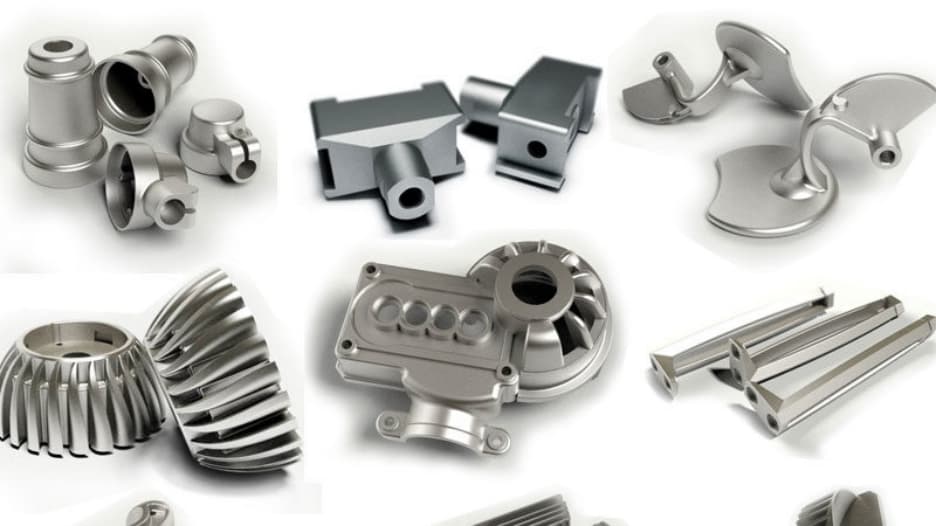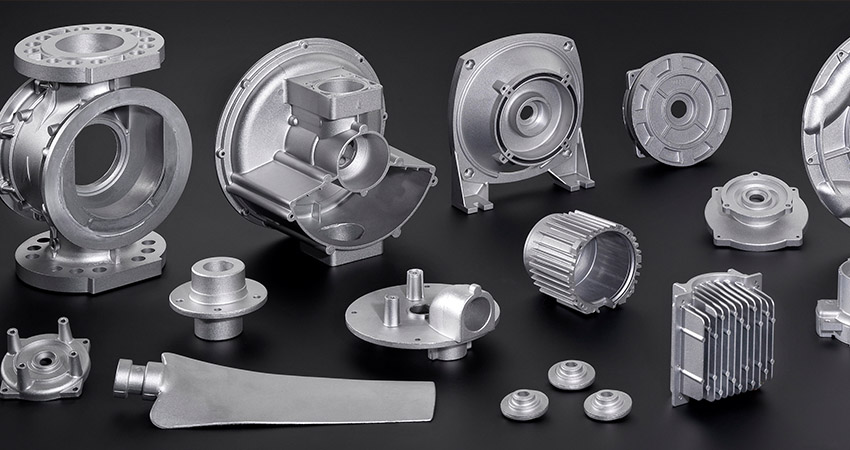A beginner’s manual to Aluminum Casting processes
Understanding the Benefits and Varieties of Aluminum Castings in Sector
Aluminum castings have actually become increasingly essential throughout different industries due to their one-of-a-kind residential or commercial properties and making flexibility. Their light-weight and corrosion-resistant nature makes them ideal for demanding applications. Various spreading techniques enable precise and intricate styles. As industries advance, understanding the variety of aluminum casting choices and their advantages is vital. This expedition questions about their future function in manufacturing and sustainability. What exists in advance for aluminum in these fields?
The Basics of Aluminum Casting Processes
Aluminum spreading procedures vary in technique, they all share an usual objective: to change liquified aluminum right into specific shapes and elements. The key techniques of light weight aluminum casting consist of sand spreading, die spreading, and financial investment casting. In sand casting, molds are developed using sand, allowing for intricate layouts however usually resulting in a harsh surface coating. Die casting uses high-pressure shot of liquified aluminum right into metal mold and mildews, generating high accuracy and smooth surface areas, suitable for automation. Financial investment casting, or lost-wax spreading, entails developing a wax pattern covered with a ceramic shell, providing remarkable detail and dimensional precision. Each technique has its certain applications and factors to consider, consisting of cost, manufacturing volume, and intricacy of the shapes produced. Recognizing these fundamental strategies is essential for sectors that depend on light weight aluminum castings to fulfill their layout and useful demands.
Secret Benefits of Making Use Of Aluminum Castings
Aluminum castings supply many benefits that make them a recommended selection in various industries. Among the key advantages is their lightweight nature, which permits easier handling and lowered delivery expenses. This characteristic contributes to improved power efficiency, especially in automotive and aerospace applications. Additionally, light weight aluminum shows superb deterioration resistance, prolonging the life expectancy of parts and decreasing maintenance demands.
One more advantage is the flexibility of aluminum castings, which can be molded right into intricate shapes, enabling ingenious layouts that conventional products may not suit. The thermal and electric conductivity of aluminum also makes it perfect for applications needing heat dissipation or efficient electric connections. Aluminum castings are recyclable, aligning with sustainability objectives and minimizing environmental impact. In general, the mix of toughness, longevity, and versatility makes light weight aluminum castings a critical element in modern production methods across several markets.
Typical Kinds Of Aluminum Castings
Aluminum castings are generated via numerous approaches, each matched for various applications and needs. Among one of the most typical strategies are sand spreading, which uses adaptability and cost-effectiveness, and pass away spreading, understood for its precision and effectiveness. Recognizing these processes is essential for selecting the ideal casting approach for specific industrial requirements.
Sand Casting Refine
A significant part of aluminum castings in industry is generated with the sand spreading procedure, which is renowned for its adaptability and cost-effectiveness. This approach involves creating a mold from a sand blend, permitting the manufacturing of intricate shapes and big elements. Sand spreading is specifically helpful for small to medium-sized manufacturing runs, as it calls for very little first investment in tooling. The procedure begins with pattern production, followed by mold and mildew prep work, pouring molten light weight aluminum, and lastly, cooling and completing. The high thermal conductivity of light weight aluminum guarantees even cooling, minimizing the risk of defects. Sand casting continues to be a preferred option for producers looking for effectiveness and flexibility in their light weight aluminum casting applications.
Die Casting Techniques
Die casting methods represent a highly reliable approach for generating light weight aluminum castings, particularly fit for high-volume manufacturing. These techniques largely include 2 usual kinds: hot chamber and chilly chamber pass away spreading. In hot chamber die spreading, the molten light weight aluminum is infused into the mold and mildew from a storage tank that is heated up, making it ideal for low-melting-point alloys. Alternatively, cold chamber die casting includes pouring the molten aluminum right into a different chamber before shot, which fits greater melting-point materials. Both techniques use precision in forming intricate geometries and accomplishing outstanding surface coatings. Furthermore, die spreading is recognized for its rapid cycle times, minimizing manufacturing expenses while preserving uniformity in high quality throughout huge amounts of parts.
Applications in the Automotive Sector
Changing vehicle style and efficiency, aluminum castings play an essential role in the vehicle industry. These castings contribute substantially to weight reduction, improving fuel effectiveness and total car dynamics. Secret applications consist of engine blocks, transmission housings, and suspension parts, where their light-weight nature and strength are crucial.
Aluminum castings also enable complicated geometries, enabling manufacturers to produce detailed layouts that optimize air flow and lower drag. This capability is especially advantageous in electrical and hybrid vehicles, where performance and effectiveness are paramount.
Furthermore, the corrosion resistance click here to read of aluminum prolongs the life-span of automobile components, decreasing upkeep expenses and boosting car reliability. The convenience of light weight aluminum castings sustains both automation and custom-made applications, making them a preferred selection amongst automobile engineers and developers. Aluminum Casting. As the industry remains to introduce, light weight aluminum castings will certainly stay a critical component in the search of innovative auto modern technologies
Aerospace Market Use
In the aerospace market, aluminum castings are integral to the layout and capability of aircraft elements. These castings are used in numerous applications, consisting of engine parts, structural elements, and indoor installations. Their lightweight nature adds to boosted fuel effectiveness and total performance, which is necessary in aerospace engineering.
Aluminum castings also provide exceptional strength-to-weight proportions, allowing suppliers to create detailed styles without endangering structural stability. The capacity to create complicated geometries makes light weight aluminum casting a preferred option for parts that require accuracy and dependability.
In addition, light weight aluminum's resistance to deterioration improves the durability of aerospace parts, reducing upkeep prices and enhancing security (Aluminum Casting). The casting procedure permits high-volume manufacturing, satisfying the industry's demands for effectiveness. Generally, aluminum castings play a critical duty beforehand aerospace modern technology and maximizing airplane style, adding to the industry's continuous technologies

Benefits Over Other Products
Aluminum castings supply significant advantages over other products, making them a preferred option in various sectors. One of the primary benefits is their lightweight nature, which adds to reduced energy consumption and improved efficiency in applications such as auto and aerospace. In addition, aluminum shows outstanding corrosion resistance, permitting long term toughness and reduced upkeep costs.
The material's premium thermal and electric conductivity further improves its appeal, specifically in applications needing heat dissipation or effective power transfer. Aluminum Casting. Aluminum Get More Info castings also provide outstanding dimensional stability, ensuring precise tolerances and decreasing the possibility of problems during the manufacturing process
In addition, the flexibility of light weight aluminum enables for complex shapes and complex layouts, which can be achieved through different casting methods. This adaptability makes light weight aluminum an important option for suppliers intending to innovate while preserving cost-effectiveness and quality. In conclusion, light weight aluminum castings stand apart as a result of their distinct mix of homes that satisfy diverse industrial needs.
Future Trends in Aluminum Casting Technology
Future trends in aluminum casting technology are increasingly concentrated on automation and the advancement of sophisticated alloys. Automation stands to boost efficiency and accuracy in casting procedures, reducing labor expenses and enhancing item consistency. Simultaneously, developments in alloy solutions assure to expand the variety of applications for light weight aluminum castings, addressing specific efficiency demands in various sectors.
Automation in Casting Procedures

Advanced Alloys Growth
With the ongoing evolution of product science, the growth of innovative alloys is readied to transform light weight aluminum casting modern technology markedly. These cutting-edge alloys are made to boost mechanical residential or commercial properties, rust resistance, and thermal security, accommodating varied industrial applications. Researchers are concentrating on this website crossbreed alloys that incorporate elements such as magnesium, silicon, and zinc to accomplish peak performance. Furthermore, advancements in computational modeling and simulation are making it possible for the prediction of alloy actions under different problems, improving the layout process. The assimilation of recycling innovations is additionally becoming crucial, allowing producers to produce high-performance aluminum castings while minimizing ecological influence. As these patterns continue, the aluminum casting industry is most likely to witness substantial enhancements in effectiveness, sustainability, and product quality.
Regularly Asked Inquiries
Exactly How Is Aluminum Casting Eco-friendly?
The inquiry of aluminum casting's environmental friendliness emerges from its recyclability and lower power consumption compared to various other steels. In addition, advancements in sustainable practices better enhance its green online reputation within making processes.
What Is the Normal Life Expectancy of Aluminum Castings?
The regular life-span of aluminum castings differs based upon application and setting, generally ranging from several years to decades. Aspects such as exposure to harsh components and mechanical stress and anxiety can substantially affect their toughness and long life.
Can Aluminum Castings Be Reused?
Aluminum castings can undoubtedly be reused. This process significantly decreases waste and conserves resources, allowing suppliers to recycle materials efficiently. Recycling light weight aluminum castings adds to sustainability and decreases the ecological impact linked with light weight aluminum production.
What Are the Usual Problems in Aluminum Castings?
Usual defects in light weight aluminum castings include porosity, shrinking, misalignment, and surface area imperfections. These concerns can develop from inadequate putting methods, improper alloy make-up, or inadequate cooling, eventually influencing the quality and performance of the end product.
How Do I Select the Right Aluminum Casting Refine?
Choosing the ideal aluminum casting procedure calls for evaluating production quantity, component intricacy, and preferred residential properties. Elements such as cost, lead time, and material qualities additionally affect the choice, making sure optimal results for certain applications.